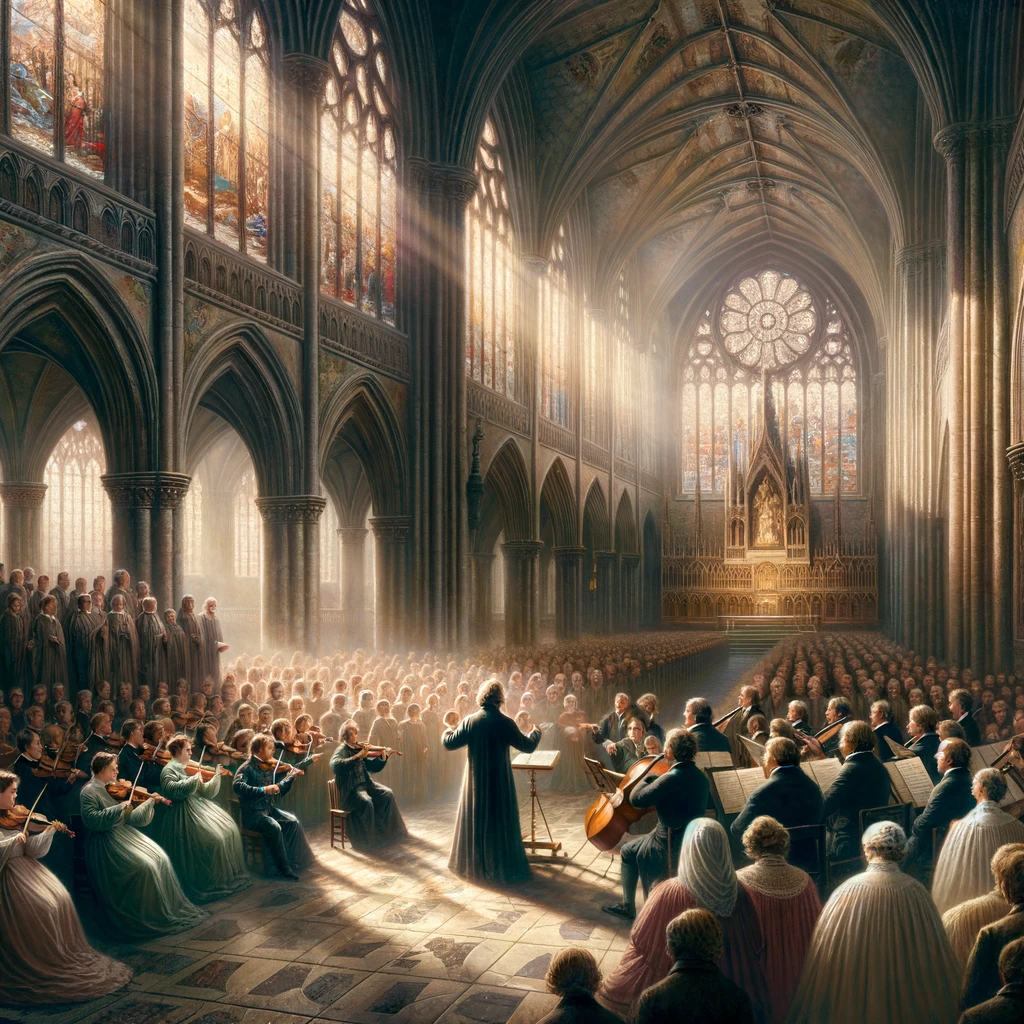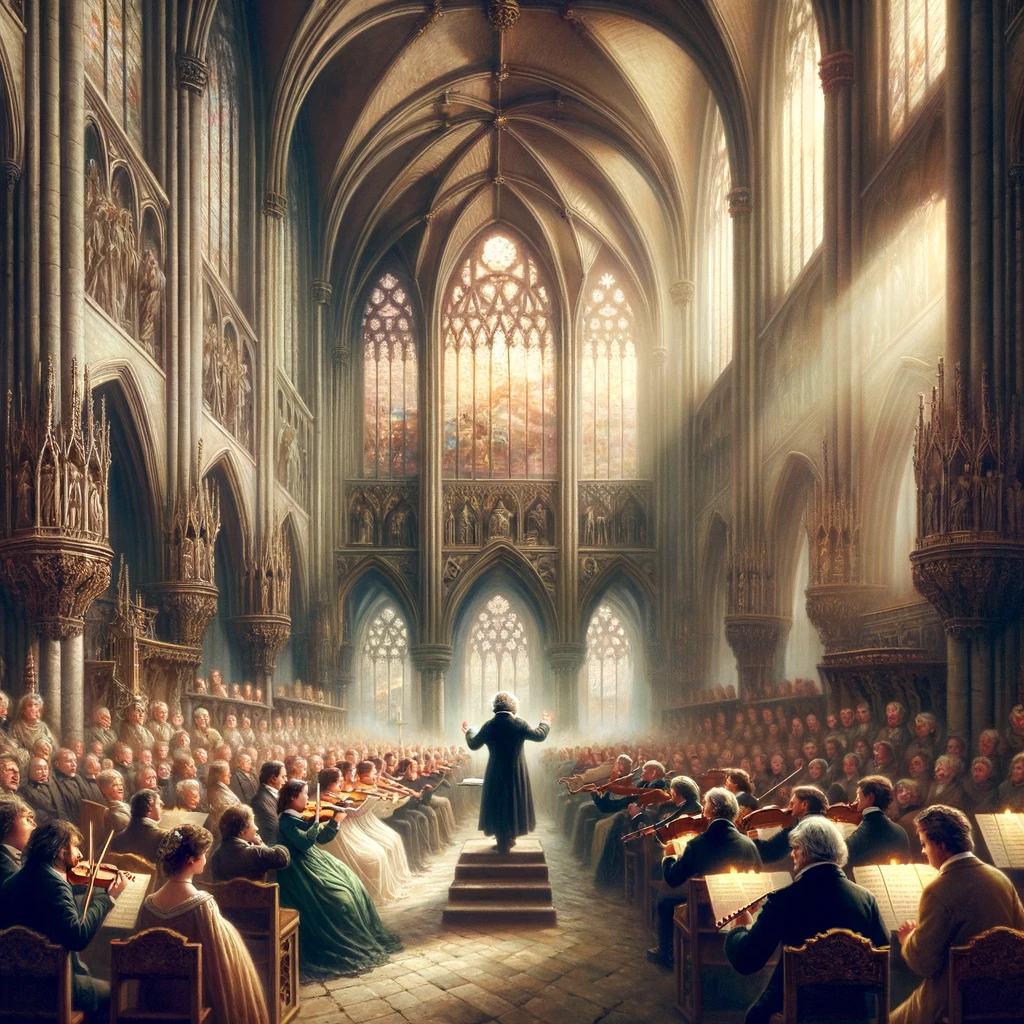
Exploring Beethoven’s Lesser-Known Sacred Music
Ludwig van Beethoven, a towering figure in classical music, is often celebrated for his symphonies and sonatas, which have profoundly influenced the course of Western music. However, his contributions to sacred music, particularly beyond the renowned Missa Solemnis, are less frequently discussed yet equally deserving of exploration. This article delves into the lesser-known aspects of Beethoven’s sacred compositions, offering a deeper understanding of his musical genius in the context of his spiritual expressions.
The Early Works: A Foundation in Faith
Beethoven’s engagement with sacred music began in his youth, rooted in the traditions of the Catholic Church. His earliest known composition in this genre is a set of nine responsories for Holy Week, written around 1775 when he was merely a teenager. These pieces, crafted under the tutelage of Christian Gottlob Neefe, Beethoven’s mentor, reflect a conventional adherence to the church modes, yet hint at the emotive power Beethoven would later fully develop.
In 1807, Beethoven composed Mass in C major, Op. 86, at the behest of Prince Nikolaus Esterházy. Though less monumental than the Missa Solemnis, this mass reveals Beethoven’s growing confidence in blending traditional liturgical forms with his unique musical language. The Mass in C major was met with a mixed reception—Esterházy himself deemed it “unbearably ridiculous and detestable,” a critique that deeply wounded Beethoven. Nevertheless, this composition is now celebrated for its lyrical beauty and innovative use of choral and orchestral forces.
The Middle Period: Experimentation and Expression
During his middle creative period, Beethoven’s personal struggles with hearing loss and existential reflection deepened his expressive range, which permeated his sacred music. One significant yet often overlooked work from this period is the Christ on the Mount of Olives (Christus am Ölberge, Op. 85), an oratorio that depicts Jesus’ emotional turmoil in the Garden of Gethsemane before his crucifixion. Premiered in 1803, this work stands out as Beethoven’s first foray into the oratorio form. It combines theatrical elements with sacred themes, creating a dramatic and humanized portrayal of Christ’s suffering.
Christ on the Mount of Olives showcases Beethoven’s ability to convey profound human emotions while adhering to the spiritual and textual demands of sacred music. The oratorio’s narrative intensity and the lyrical solos forecast the emotive power he would later achieve in the Missa Solemnis.
Late Period: Culmination in the Missa Solemnis
The culmination of Beethoven’s sacred music is undoubtedly the Missa Solemnis, a grand, complex work that occupied him from 1819 to 1823. Originally intended for the installation of his patron Archduke Rudolph as Archbishop of Olmütz, the Missa was not completed in time for the ceremony. This missa is often the primary focus when discussing Beethoven’s sacred works, but it was neither his beginning nor his end in the genre.
Beyond the Missa Solemnis, Beethoven’s late sketches and lesser-known pieces suggest a continued, albeit sporadic, engagement with sacred themes. Notably, his setting of the Pater Noster (Our Father) and a brief Kyrie show an unrelenting pursuit of spiritual music exploration, even as his health declined.
Legacy and Influence
The spiritual dimension of Beethoven’s music, particularly evident in his sacred works, reflects his personal search for meaning and transcendence through art. Beethoven saw music as a moral force, a belief that imbued his sacred compositions with a profound sense of purpose. His influence on sacred music extends beyond the notes on the page; he expanded the expressive potential of liturgical music, infusing it with personal conviction and universal appeal.
Beethoven’s sacred compositions, while not as prolific or as celebrated as his symphonic works, are crucial for understanding the full scope of his musical genius. They reveal a composer who continually sought to reconcile his artistic ambitions with his spiritual beliefs, offering a window into the soul of one of music’s most revered figures.
Ludwig van Beethoven’s journey through the realm of sacred music is marked by both innovation and introspection. From his early masses to the monumental Missa Solemnis and beyond, Beethoven’s sacred works challenge and enrich our understanding of his artistic legacy. By examining these lesser-known compositions, we gain deeper insights into the spiritual and musical quests that defined Beethoven’s life and works. As we continue to explore and perform these pieces, we ensure that this vital aspect of his oeuvre receives the appreciation and recognition it deserves.

Exploring Further: Personal Beliefs and Their Musical Reflection
Ludwig van Beethoven’s personal beliefs, particularly his complex relationship with religion, deeply influenced his sacred compositions. Unlike his contemporaries who often followed the strict dogmatic frameworks of their time, Beethoven’s approach to spirituality was intensely personal and somewhat unorthodox. He was not overtly religious in the traditional sense but was profoundly spiritual, seeing God through the lens of enlightenment ideals and personal introspection. This worldview is encapsulated in his famous declaration: “To the victims of tyranny and kingcraft, God and Nature linked my soul; I could be serving no other.”
“Heiligenstadt Testament”: A Window into Beethoven’s Soul
A pivotal document revealing Beethoven’s spiritual and emotional state is the Heiligenstadt Testament, written in 1802. This heartfelt letter to his brothers, written at a time when Beethoven was grappling with the despair of his worsening deafness, also reflects his resolve to continue living through his artistic creations. In this testament, Beethoven expresses a deep sense of isolation but also a strong conviction in the moral and spiritual power of his music to communicate and transcend personal suffering. This document is crucial for understanding the emotional depth that underpins his later sacred works.
The Importance of Individualism in Beethoven’s Sacred Music
Beethoven’s individualistic streak is evident in how he personalized the liturgical texts he set to music. For instance, in the Missa Solemnis, he diverges from the traditional mass composition by emphasizing humanistic elements over doctrinal adherence. This is seen in the “Dona nobis pacem” movement, where he introduces a military march to reflect the real-world context of war and peace, blending the sacred with the secular to deliver a universal plea for peace.
Rediscovered Works and Unfinished Sketches
Recent musicological research has shed light on some of Beethoven’s lesser-known and unfinished sacred works. These include sketches for additional masses and a few isolated pieces such as motets and hymns, which illustrate his ongoing commitment to exploring sacred themes. The Hallelujah from Christ on the Mount of Olives is particularly noteworthy, showcasing Beethoven’s skill in fusing liturgical solemnity with dramatic flair.
Beethoven’s Last Musical Thoughts: The Late String Quartets
While not sacred in the strictest sense, Beethoven’s late string quartets, especially the Heiliger Dankgesang (A Convalescent’s Holy Song of Thanksgiving) in the String Quartet No. 15 in A minor, Op. 132, provide profound insight into his spiritual reflections towards the end of his life. Written after recovering from a serious illness, this piece is structured as a modal hymn of thanks to the divine, blending sacred and secular musical languages to express gratitude and renewed strength. This quartet, with its contemplative quality, can be seen as a spiritual testament parallel to the grandeur of the Missa Solemnis.
Conclusion: Beethoven’s Universal Message
The depth of Beethoven’s sacred music goes beyond conventional religious expression to touch on universal themes of human struggle, redemption, and transcendence. His ability to infuse these compositions with personal conviction and philosophical depth ensures that they resonate with listeners across different cultural and temporal contexts, inviting each to find their own spiritual and emotional connections.
Beethoven’s legacy in sacred music is a testament to his belief in the power of music to uplift, heal, and transcend the immediate confines of earthly existence. As we revisit and reflect on these works, they not only enrich our understanding of Beethoven as a composer but also as a profound thinker and a relentless seeker of truth through the sublime language of music.
References:
- “Beethoven: The Music and the Life” by Lewis Lockwood.
- “Beethoven: A Biography” by Jan Swafford.
- “Beethoven’s Church Music: Missa Solemnis and Beyond” by Theodore Albrecht.
- “Beethoven’s Oratorios: Christ on the Mount of Olives” by Musicological Society Notes.
- “The Heiligenstadt Testament: A New Analysis” by Music History Journal.